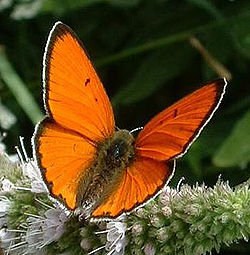Current range
Lycaena dispar occurs between latitudes 40° and 60° across Eurasia. [2] The species is currently found in: Armenia, Austria, Azerbaijan, Belarus, Belgium, Bulgaria, China, Croatia, Czech Republic, Estonia, Finland, France, Georgia, Germany, Greece, Hungary, Italy, Kazakhstan, Republic of Korea, Latvia, Lithuania, Luxembourg, Moldova, Mongolia, Montenegro, Netherlands, Poland, Russian Federation, Serbia, Slovakia, Slovenia, Switzerland, Türkiye, Ukraine and Uzbekistan. [1] [7]
The species shows contrasting population trends across its range: severe decline in north-western Europe, stability or expansion in central and northern Europe, and mixed status in Asia. [3]
Regional variations
Western Europe
The species is regionally extinct in the United Kingdom (since 1864) and Ireland (failed reintroductions). [1] In the Netherlands, populations of L. d. batavus persist and are largely monophagous on R. hydrolapathum. [2] Western European populations have suffered from extensive drainage of wetland habitats. In Luxembourg, monitoring from 2007 to 2015 documented the species at 183 sites across 33 municipalities in the south-west and west of the country. Populations primarily utilize R. obtusifolius and R. crispus as host plants and correlate with grassland distribution and habitat mosaics. [8]
Northern Europe
Estonia represents the species' northern range expansion. Absent until the 20th century, L. dispar was first recorded near Tartu in 1947. [2] The species has since expanded north-westward and achieved widespread status, though it remains absent from Estonia's western islands. Estonian populations are univoltine (single-brooded) with flight period from late June to late July, and utilize primarily R. crispus and R. obtusifolius as host plants. [2]
Central Europe
In central Europe, L. dispar has adapted to a broader range of habitats including drier areas, fallows and urban wetlands. [2] Populations in Germany and Austria are characteristically oligophagous on various Rumex species. [2] Vienna's urban populations demonstrate successful colonization of anthropogenic habitats: a 2012 study documented 2,457 eggs at 23 sites within the municipality. [3] In Croatia's Zagorje region, populations remain locally numerous but are declining due to invasive plants. [9]
Southern Europe
The species' range extends south to Mount Olympus in Greece, where it was observed in July 2011. [10] Southern populations may produce a partial third generation in favourable conditions. [2]
Eastern Asia
Field monitoring in South Korea demonstrated significant range expansion southward from the species' previously known north-western strongholds. The 2024 study documented populations at 15 sites spanning six provinces. Genetic diversity patterns, combined with field observations, demonstrate that South Korean populations maintain strong connectivity and are not experiencing the isolation previously assumed. These findings led researchers to recommend downgrading the species from its Near Threatened status in South Korea. [4]








